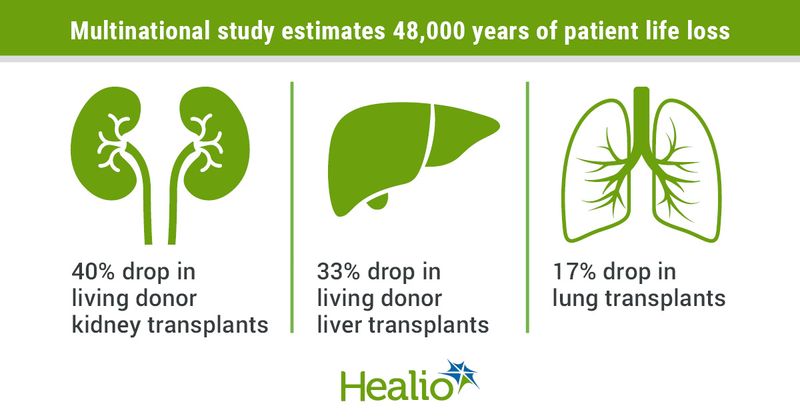New data show organ transplants fell by 31% worldwide during COVID-19 pandemic
A multinational study illuminates the global impact of COVID-19 on transplantation, with an observed 31% drop in the number of solid organ transplants performed during the first wave of the pandemic compared with the previous year.
This decline, according to study estimates, resulted in approximately 48,000 years of patient life lost.

The data were simultaneously published in the Lancet Public Health and presented at the 2021 European Society for Organ Transplantation Congress held in Milan.
Transplants performed in 2020 vs 2019
“The first wave of COVID-19 had a devastating impact on the number of transplants across many countries, affecting patient waiting lists and regrettably leading to a substantial loss of life,” lead author Olivier Aubert, MD, assistant professor at the Paris Translational Research Centre for Organ Transplantation, said in a related press release.
For the study, researchers included transplantation data from 22 countries and compared transplant activity during the pandemic (from Jan. 1 to Dec. 30, 2020) with that from the previous year.
“Based on the annual data available from the official WHO and Global Observatory on Donation and Transplantation, the 22 countries included had 86,942 solid organs procured for transplantation in 2019, which represented 62.4% of the total worldwide transplant activity,” the researchers wrote.
Findings indicated that transplant activity decreased in all of the countries studied, with kidney transplantation seeing the largest drop. Specifically, researchers observed that living donor kidney transplants declined by 40%, while living donor liver transplants fell by 33%.
Regarding deceased donor transplants, researchers found a 12%, 9%, 17% and 5% decline in kidney, liver, lung and heart transplants, respectively.
Understanding global variations to improve ‘pandemic preparedness’
“Beyond the near universal reduction in transplant activity, certain countries and regions managed to carry-out procedures despite major challenges presented by the pandemic. These findings warrant further analysis on a regional, national and global level to understand why reductions did or did not occur,” Aubert said of an observation showing global variations in transplant activity (researchers found that while some countries sustained transplant rates, other countries saw declines of 90% or even the cessation of living donor kidney and liver transplants).
“The ability of specific countries, such as Germany and certain regions in the USA, to maintain transplant volume despite the urgency of controlling COVID-19 spread holds an important lesson for future waves of COVID-19 infection and other pandemics,” the researchers wrote. “Likewise, countries such as Belgium and Italy showed efforts to sustain transplant volume despite a relatively higher number of deaths per million from COVID-19.
“ ... This study shows how international variation in medical practice can reveal opportunities to improve public health. Our research highlights the value of national transplant registries that provide an exhaustive record of transplant procedures and enable scrutiny of organ use and transplant outcomes across borders.”
To this end, the authors have developed “an open-access dashboard that presents data interactively for solid organ transplant activities and COVID-19 cases,” according to the press release.
“Understanding how different countries and health care systems responded to COVID-19-related challenges can facilitate improved pandemic preparedness and how to safely maintain transplant programs to provide life-saving procedures for patients,” Aubert said.

